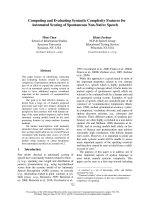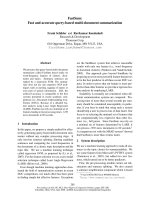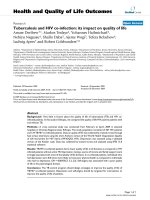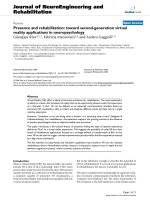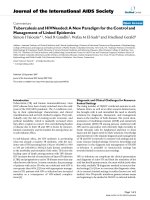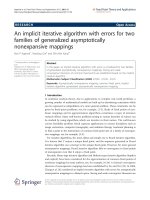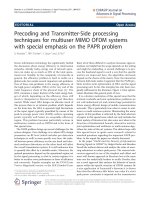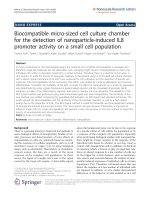Báo cáo hóa học: " Fast and Accurate Ground Truth Generation for Skew-Tolerance Evaluation of Page Segmentation Algorithms" potx
Bạn đang xem bản rút gọn của tài liệu. Xem và tải ngay bản đầy đủ của tài liệu tại đây (6.14 MB, 10 trang )
Hindawi Publishing Corporation
EURASIP Journal on Applied Signal Processing
Volume 2006, Article ID 12093, Pages 1–10
DOI 10.1155/ASP/2006/12093
Fast and Accurate Ground Truth Generation for
Skew-Tolerance Evaluation of Page
Segmentation Algorithms
Oleg Okun and Matti Pietik
¨
ainen
Infotech Oulu and Department of Electrical and Information Engineering, Machine Vision Group,
University of Oulu, P.O.Box 4500, FI-90014, Finland
Received 15 February 2005; Revised 30 May 2005; Accepted 12 July 2005
Many image segmentation algorithms are known, but often there is an inherent obstacle in the unbiased evaluation of segmentation
quality: the absence or lack of a common objective representation for segmentation results. Such a representation, known as the
ground truth, is a description of what one should obtain as the result of ideal segmentation, independently of the segmentation
algorithm used. The creation of ground truth is a laborious process and therefore any degree of automation is always welcome.
Document image analysis is one of the areas where ground truths are employed. In this paper, we describe an automated tool called
GROTTO intended to generate ground truths for skewed document images, which can be used for the performance evaluation of
page segmentation algorithms. Some of these algorithms are claimed to be insensitive to skew (tilt of text lines). However, this fact
is usually supported only by a visual comparison of what one obtains and what one should obtain since ground truths are mostly
available for upright images, that is, those without skew. As a result, the evaluation is both subjective; that is, prone to errors, and
tedious. Our tool allows users to quickly and easily produce many sufficiently accurate ground truths that can be employed in
practice and therefore it facilitates automatic performance evaluation. The main idea is to utilize the ground truths available for
upright images and the concept of the representative square [9] in order to produce the ground truths for skewed images. The
usefulness of our tool is demonstrated through a number of experiments with real-document images of complex layout.
Copyright © 2006 Hindawi Publishing Corporation. All rights reserved.
1. INTRODUCTION
Segmentation is an important step in image analysis since it
detects homogeneous regions whose characteristics can then
be computed and analyzed, for example, for discriminating
between different classes of objects such as faces and non-
faces. However, the unbiased evaluation of segmentation re-
sults is difficult because it requires an ideal description of
what one should obtain as the result of segmentation of a
certain image regardless of the segmentation algorithm. This
ideal description, known as the ground truth, can be utilized
for judging whether segmentation is correct or not, and how
well a given image is segmented. The generation of ground
truths is laborious and often prone to errors, especially if
done manually. Thus, any degree of automation brought to
this procedure is typically welcome.
Document page seg mentation is one of the areas of im-
age analysis where ground truths are to be employed. Page
segmentation divides an image of a certain document, such
as a newspaper article or advertisement, into homogeneous
regions, each containing data of a particular ty pe such as text,
graphics, or picture. The accuracy of page segmentation is of
great importance since segmentation results will be an input
for higher-level operations, and er rors in segmentation can
lead to those in character recognition. Performance evalua-
tion of page segmentation algorithms is therefore necessary
because it can help to identify errors inherent to a given al-
gorithm and to understand their reasons. The performance
is ty pically assessed either visually by a human or by using
ground truths.
The first approach consists of visually checking the ob-
tained results and making conclusions about their correct-
ness. This approach is subjective (thus unreliable) and te-
dious. That is why researchers have normally used a small
or relatively moderate number of images in testing page seg-
mentation algorithms.
The second alternative is automated and therefore more
attractive when it is necessary to process a large num-
ber of images. It uses a special (usually text) file, called a
ground truth (GT), for each image, containing a description
of different regions that should be detected during correct
segmentation. This description typically includes (for each
2 EURASIP Journal on Applied Signal Processing
region) a polygon or rectangle surrounding the region to-
gether with the type of data constituting the region (types
are text, graphics, picture), which is compared to the results
obtained after applying the page segmentation algorithm un-
der consideration. It is worthy to mention that several differ-
ent correct segmentations of the same image are sometimes
possible, and it is often difficult (or may be even hardly pos-
sible) to define the term “best or ideal segmentation”, which
all other segmentations can be compared to.
Inthispaper,wedescribeanexperimentaltoolcalled
GROTTO (ground truthing tool) to generate many ground
truths in an automatic and computationally cheap manner
when page skew (tilt of text lines) is present.
1
To ou r b e s t
knowledge, no existing ground truthing method [2, 5, 7, 8,
12] explicitly aims at this task. Its importance is, however,
motivated by the following reasons. A majority of the existing
GTs were created for upright images, that is, for those with-
out skew, because their creation is usually quite time con-
suming. To be able to use them when skew is present, one
typically needs to scan the skewed page and then to com-
pensate for the skew. In this case, it will be difficult to judge
the skew tolera nce of a given page segmentation algorithm
because segmentation will be done when there is no skew.
Errors in skew estimation are also possible, which can dete-
riorate the whole process.
Keeping this in mind, GROTTO attempts to reduce the
cost of GT creation by making some of the most laborious
operations more automatic. The main idea is to use the GTs
for upright images in order to generate those for skewed im-
ages. We consider that the rotation transformation applied to
the upright image is sufficient to produce the skewed image
for any angle. Such an assumption gives us two advantages.
Firstly, we know the skew angle and secondly, we exclude the
scaling and translation, that is, we avoid a sophisticated, time
consuming and not always accurate document registration
procedure.
2
In fact, neither printing nor scanning of the orig-
inal document is necessary in our approach. All that we need
is the GT for the corresponding upright image. In the next
section, modern approaches to ground truth generation are
briefly reviewed.
2. BRIEF OVERVIEW OF GROUND TRUTHING
STRATEGIES
Because our interest in this paper is the GT generation for
skew-tolerance evaluation, we will not consider methods
aiming at pure text images, where the task is mostly to cor-
rectly place bounding rectangles around each character (for
details, see [5, 6, 8, 10]).
When using GTs, there are two different approaches
to the performance evaluation of page segmentation algo-
1
We concentrate in our article on this type of degradation and do not con-
sider other possible t ypes such as scaling, which typically less frequently
occur for page images.
2
Document registration may be able to solve a more complex and general
task than we consider but at the expense of higher complexity and as a
result, of higher chances for failures. In contrast, we aim at a simpler so-
lution while sacrificing some generality.
rithms. In the first approach, the judgment about segmen-
tation quality is based on OCR results [4, 7, 10]. In this case,
the GT is often a simple sequence of correct characters. It is
sometimes assumed that the OCR errors do not result from
segmentation errors [7], so that the number of operations
(manipulations with characters and text blocks) needed to
convert the OCR output into the correct result can be used to
evaluate the segmentation per formance. This approach may
hide the reason for error when both types of error appear in
the same place and it does not make the segmentation evalu-
ation independent of the whole document analysis system.
In the second approach, the segmentation results are di-
rectly compared with the corresponding GTs without using
OCR [2, 3, 11, 12]. In this case, the GTs contain region de-
scriptions as sets of pixels [11, 12], rectangular zones [3], or
isothetic polygons whose edges are only horizontal or vertical
[2].
When ground truthing is done at the pixel level [11, 12],
it provides the finest possible details and can represent re-
gionsofarbitraryshape.However,asreportedin[3], there
can be more than 15 million pixels per page digitized at
400 dpi. That is why it usually takes much time to verify and
edit such GTs. The evaluation of the segmentation quality
is achieved by testing the overlap b etween sets of pixels. It
consists of computing the number of splittings and mergings
needed to obtain correct segmentation.
The representation of regions as rectangular zones takes
less memory than the pixel-based one, but it is less efficient
because it is only suitable for representing constrained lay-
outs, where all regions have a rectangular shape and no adja-
cent bounding rectangles are overlapped. The segmentation
performance is evaluated by the overlap and alignment of
zones in the GT and those obtained after segmentation [3].
No calculation of how zones were split, merged, missed, or
inserted is done by suggesting that this information is diffi-
cult to derive and therefore it will be quite difficult to make
the right conclusions based on it. It is important to notice
that the method [3] only checks the spatial correspondence
of zones by ignoring their class labels (text, graphics, back-
ground) so that the obtained GTs do not contain complete
information about segmentation errors.
The representation of page regions as isothetic polygons
[2] tries to combine the advantages of pixel- and zone-based
schemes, while aiming to overcome their drawbacks. It is
supposed that any arbitrarily shaped region can be described
by an isothetic polygon that can be decomposed into a num-
ber of rectangles called horizontal intervals in [2]. Such a
scheme seems to be flexible and efficientenoughtodeal
with complex nonrectangular regions and nonuniform re-
gion orientation, and it describes regions without significant
excess to the background. Also it has lower memory require-
ments than a bitmap (though they may be higher than those
for the zone-based scheme). The GTs are automatically gen-
erated by using the method described in [1]. After that, a
manual correction of the GT may be necessary. The corre-
spondence between the GT and segmentation results is de-
termined by interval overlap. In spite of the advantages of
isothetic polygons, it is still not very clear how to obtain those
O. Okun and M. Pietik
¨
ainen 3
polygons automatically from images with color and textured
background (the authors in [2] claim that it is possible, but
no examples were given). The method [1] that is used to con-
struct such polygons, exploits the concept of white tiles (or
white background spaces) surrounding document regions. In
the case of color images, for example, the background may
not be white or it may not have a single color for all regions
and it may not be uniform.
3. OUR APPROACH TO THE PROBLEM
As one can see from the brief discussion of various ground
truthing strategies, one of the first tasks is to choose a proper
representation for page regions. The region representation
affects the method of comparing a GT and segmented image.
To summarize, there are three main alternatives: set of
pixels, rectangular zone, and polygon. When a region is de-
scribed as a set of pixels [12], it will take a lot of memory to
keep this representation and a lot of time to manipulate it.
Rectangular zones [3] represent regions in a m ore compact
manner than pixels, but they cannot a ccurately enough de-
scribe complex-shaped nonrectangular regions and they are
not suitable when skew is present. Polygons can deal with
both problems mentioned, but they are not flexible enough
when it is necessary to access the data inside them (it will
usually take much more time than when using rectangles).
One exception is isothetic polygons [2], but they need to be
partitioned into a number of rectangles before being really
convenient to use, and it seems that this representation is re-
stricted to binary images only.
Since no representation scheme has clear advantages over
the others and there are no established standards, we intro-
duce our own representation based on image partitioning
into small nonoverlapping blocks of N
× N pixels, where N
depends on the image resolution and is determined by the
formula N
≤ 2 · (res /25), where res is the resolution in dots
per inch (dpi), res /25 is the resolution in dots per mm, and 2
means two mm. We assume that in any case the correspond-
ing block on the paper should not occupy an area larger than
2
× 2mm
2
. For example, the maximum value of N is equal to
24 for a resolution of 300 dpi. In our opinion, the block par-
titioning combines advantages of other representations such
as compactness, easiness and direct access to data, applicabil-
ity to different image types (binary, grayscale, and color) and
various document layouts (rectangular and arbitrary), and
tolerance to skew. It is also widely used in image compres-
sion.
The block-based GT can be defined as a 2D array of num-
bers, each of which is a block label associated with the follow-
ing classes: text (T), background (B), binary graphics (G),
and grayscale or colored image (I). If a block contains data of
several classes, it has a composite label including the labels of
all classes. That is, 11 composite labels are possible in addi-
tion to 4 noncomposite ones. Given that n
row
× n
col
are sizes
of the original image, sizes of the block-based GT associated
with this image are much smaller (
n
row
/N +0.5×n
col
/N +
0.5
), where · means the smallest integer closest to a given
number; 0.5isintroducedtodealwithimagesizesthatare
Figure 1: Direct approach to SGT generation.
not multiples of N.
Based on such a definition of the GT, the correspondence
between the GT and segmentation results can be found in
a straightforward way—by computing the difference of class
labels of the blocks.Difference statistics, found for each of the
11 cases, fully quantify and qualify segmentation results. It
is also quite easy to convert the pixel-, zone-, and even some
polygon-based (such as composed of a set of rectangles) GTs
to the block-based format.
4. CONCEPT OF THE REPRESENTATIVE SQUARE
Let us suppose that a block-based GT for an upright image
(UGT) is available (we wil l show how to generate it below).
By having this GT and by knowing the skew angle α and N,
the problem now is how to obtain the GT for the skewed
image (SGT). A straightforward solution could be to par-
tition the skewed image into N
× N pixel blocks, to rotate
the corner points of each block in that image by
−α around
the image center, and finally to match the rotated block and
blocks in the upright image in order to determine a label of
the block in question. We call this the direct approach. How-
ever, labeling may not be simple, especially if one would like
to assign labels based on the intersection area of blocks (see
Figure 1) b ecause those areas are polygons rather than rect-
angles.
Because of this reason, we employ the concept of the rep-
resentative square [9].
Definition 1. The representative square (RS) of a given block
in the skewed image is a square slanted by angle α (α
∈
[−90
◦
,+90
◦
]) and placed inside the block so that its corner
points lie on block sides (see Figure 2).
The angle by which the RS is slanted is equal to the de-
sired skew angle for which the GT needs to be created.
The following proposition is true for any RS (proof is
given in [9]).
Proposition 1. Let ABCD and A
B
C
D
be a block in the
skewed image and its RS, respectively. In this case, the ratio
r
= S
RS
/S
Block
≥ 0.5,whereS
RS
and S
Block
are the RS and block
areas, respectively.
That is, the RS always occupies at least half the area of a
block in the skewed image. Since the maximum sizes of this
block on the paper are very small, we can use the RS instead
4 EURASIP Journal on Applied Signal Processing
A
A
B
D
B
D
C
C
α
= 25
◦
Figure 2: Representative square A
B
C
D
of the block ABCD.
of the corresponding block (i.e., why it is called representa-
tive) without loosing much data.
Notice that all that is necessary to do is to model the doc-
ument skew. However, we neither scan the skewed page nor
rotate the upright image, but use the GT for the upright im-
age and the concept of the representative square in order to
generate the GTs for the skewed images. As will be shown,
this leads to very fast processing, while the results are stil l ac-
curate to apply our technique in practice.
5. SGT GENERATION METHOD
Given a skew angle α (we assume that positive (negative) an-
gles correspond to clockwise (counterclockwise) rotation),
N, and the corresponding block-based UGT, then the SGT
generation, using the concept of the representative square,
consists of the following steps.
(1) Given the width and height of the upright image, com-
pute the width a nd height for the skewed image.
(2) Partition the skewed image into nonoverlapping
blocks of N
×N pixels. Each block can be considered as
one big pixel so that it is possible to speak about rows
and columns of blocks.
(3) Compute coordinates of the point A
(see Figure 2)for
the upper-left block in the skewed image and coordi-
nates of this point and the point C
in the upright im-
age when rotating both points about the image center
by
−α.
(4) Scan the blocks from left to right, top to bottom. For
each block, find the position of the rotated (about
the center of the skewed image by
−α) RS in the up-
right image and classify the corresponding block in
question based on the labels of the UGT blocks it
crosses.
Given H and W (heightandwidthoftheuprightim-
age), the corresponding H
and W
of the skewed image are
computed as W
= H| sin α| + W cos α and H
= H cos α +
W
| sin α|.
From the proof of Proposition 1, RS width (height) d
RS
is equal to N/(| sin α| +cosα). Coordinates of the point
A
of the upper-left block in the skewed image are (here
and further we assume that the upper-left image corner has
coordinates (1,1))
x
skewed
A
=
⎧
⎨
⎩
d
RS
sin α if α ≥ 0,
1 otherwise,
y
skewed
A
=
⎧
⎨
⎩
1ifα ≥ 0,
d
RS
| sin α| otherwise.
(1)
When rotating A
about the center of the skewed image
by
−α, we obtain that its coordinates in the upright image are
determined for α
≥ 0as
x
upright
A
= x
upright
center
+
1 − x
skewed
center
cos α +
1 − y
skewed
center
sin α
+ d
RS
sin α cos α,
y
upright
A
= y
upright
center
−
1 − x
skewed
center
sin α +
1 − y
skewed
center
cos α
− d
RS
sin α sin α,
(2)
and for α<0 they are
x
upright
A
= x
upright
center
+
1 − x
skewed
center
cos α +
1 − y
skewed
center
sin α
+ d
RS
| sin α| sin α,
y
upright
A
= y
upright
center
−
1 − x
skewed
center
sin α +
1 − y
skewed
center
cos α
+ d
RS
| sin α| cos α.
(3)
Coordinates of C
in the upright image are trivial to com-
pute because the rotation transformation preserves distances,
that is, x
upright
C
= x
upright
A
+ d
RS
and y
upright
C
= y
upright
A
+ d
RS
.
By knowing x
upright
A
, y
upright
A
, x
upright
C
, y
upright
C
computed for
the upper-left block in the skewed image, it is now very easy
to find these coordinates for the other blocks without any
rotation. Thus this will speed up SGT generation because the
number of floating point oper ations is greatly reduced. It is
easy to verify that the following formulas are correct for two
adjacent blocks previous and next in the same row:
x
upright
A
(next) = x
upright
A
(previous) + N cos α,
y
upright
A
(next) = y
upright
A
(previous) − N sin α,
x
upright
C
(next) = x
upright
A
(next) + d
RS
,
y
upright
C
(next) = y
upright
A
(next) + d
RS
.
(4)
O. Okun and M. Pietik
¨
ainen 5
Figure 3: Four cases of intersection of a rotated RS (shown dashed) and blocks in the upright image.
For two adjacent blocks previous and next located in the
same column, the formulas are
x
upright
A
(next) = x
upright
A
(previous) + N sin α,
y
upright
A
(next) = y
upright
A
(previous) + N cos α,
x
upright
C
(next) = x
upright
A
(next) + d
RS
,
y
upright
C
(next) = y
upright
A
(next) + d
RS
.
(5)
After the coordinates of A
and C
in the upright image
have been computed, the task is to label blocks in the skewed
image. Four cases are only possible as shown in Figure 3.
Four corner points of each RS are checked to determine
which UGT blocks they belong to. Initially a ll blocks in the
skewed image are labelled as background. Blocks whose RSs
lie completely inside the zone of class T change their labels
to T, while blocks whose RSs cross the border between two
zones with different labels obtain both labels.
6. GROTTO
Having described the theory behind block-based ground
truth generation, GROTTO is introduced in detail in this sec-
tion. Its main modes of operation are the following.
(i) Given a raw image (either upright or skewed), that is,
one without GT, generate a block-based GT.
(ii) Given a block-based GT for an upright image, generate
one or several block-based GTs for the specified skew
angle and range of skew angles.
(iii) Given a block-based GT for an upright or skewed im-
age, verify the accuracy of generation for this GT.
6.1. Mode 1: GT generation for raw images
With this mode, the input image has no GT and the task is
to generate a block-based GT. After opening the image and
setting two parameters (image resolution in dpi and block
size in pixels), a user should manually detect page regions ei-
ther as rectangles or as arbitrary polygons and assign a class
label to each detected region. Rectangles can be nested in
other rectangles or polygons but polygons cannot. Further-
more, the user can edit regions by resizing rectangles, chang-
ing region class labels, deleting polygons or rectangles, and
partitioning polygons into rectangles. The last operation is
done automatically and it is mandator y because we need to
have a zone-based representation of regions before GT gen-
eration. This representation is also useful to obtain because
there are many other GTs based on it. It is worthy to say that
many known ground truthing methods rely on manual re-
gion extraction before GT generation. This is because the re-
gions should be extracted ver y accurately, otherwise ground
truthing is meaningless. The manual extraction can guaran-
tee this if done carefully, while there is no page segmentation
method that can outperform all the others and not be prone
to errors.
Polygon partitioning is done with a split-and-merge type
procedure. First, the bounding box of the polygon in ques-
tion is divided into N
×N pixels blocks and the center of each
block is checked to determine whether this block belongs to
the polygon or not. When doing this, each block gets one of
the labels (0:background; 1:block belongs to the polygon in
question; and 2:block belongs to another polygon or rectan-
gle). After that, the polygon’s bounding box recursively splits
into smaller rectangles in alternating horizontal and vertical
directions until a given rectangle contains all 1’s or/and 0’s
or its size is smaller than one block. After each split step, all
rectangles obtained by then are checked for possible merging.
A criterion for merging is that two rectangl es should have
the same length of their common border. Rectangles contain-
ing only 0’s or/and 2’s a re eliminated from further processing
and excluded from the list of rectangles. The representation
obtained after polygon partitioning is called a zone-based GT.
Examples of polygon partitioning are given in Figure 4.
To obtain a UGT, we analyze zones one-by-one by super-
imposing each on a block-based partitioned upright image.
For each zone, all blocks located completely inside or cross-
ing it get a class label of that zone. In the first case, blocks
are not further processed, while in the second case, the area
of intersection between the zone and each block is computed
and accumulated in the 12 most significant bits of a 16- bits
value associated with a block (the 4 least sig nificant bits are
used as a class label).
After all zones have been processed, blocks with values
higher than 15 (2
4
− 1) are analyzed because the y contain
data from several classes. If the intersection area for a block
is more than (it can happen when adjacent zones are over-
lapped) or equal to N
× N, it means that there is no back-
ground space in a block; otherw ise, the label “background”
is added to the other labels. Because N cannot be more
6 EURASIP Journal on Applied Signal Processing
500
1000
1500
2000
2500
3000
500 1000 1500 2000
500
1000
1500
2000
2500
3000
500 1000 1500 2000
500
1000
1500
2000
2500
3000
500 1000 1500 2000
500
1000
1500
2000
2500
3000
500 1000 1500 2000
500
1000
1500
2000
2500
3000
500 1000 1500 2000
500
1000
1500
2000
2500
3000
500 1000 1500 2000
Figure 4: Results of manual region detection and automatic polygon partitioning into rectangles. Yellow, green, and blue rectangles and
polygons enclose image, text, and graphics regions, respectively.
than 24 for 300 dpi and 32 for 400 dpi, which are the most
wide-spread image resolutions, 12 bits are quite enough to
represent values of the intersection area in many real cases.
6.2. Mode 2: GT generation for skewed images
By having a zone-based region representation, the user can
automatically and quickly generate SGTs for a specified range
of skew angles or just for a single angle. The process of SGT
generation is described in Section 5 in detail and it needs
a UGT. The basic operations are the same as they are for
Mode 1.
6.3. Mode 3: verification of GT generation
Having a generated SGT, one may ask whether it was accu-
rately generated based on the respective UGT or not. An-
other question would be how accurate this generation was.
To answer to these questions, GROTTO allows a user to au-
tomatically verify the quality of an SGT by comparing the
generated SGT and the so-called ideal GT (IGT). This com-
parison defines the absolute performance of a system. In other
words, it means a comparison between the performance of
our method of GT generation and that of the ideal one.
Though the IGT is also block-based, its generation em-
ploys different principles. First, a list of adjacency is created
that includes IDs of the zones in a UGT that either overlap
or have a common border. For such zones, if a block con-
tains data from two zones, one does not need to add a back-
ground label. It is quite trivial to determine whether back-
ground space is between two zones or not.
There is no background between zones, that is, two
zones are adjacent, only if the following conditions are both
satisfied:
W
1
+ W
2
≥ max
x
ur
2
− x
ul
1
+1,x
ur
1
− x
ul
2
+1
,
H
1
+ H
2
≥ max
y
ll
2
− y
ul
1
+1,y
ll
1
− y
ul
2
+1
,
(6)
where W
i
(H
i
)(i = 1, 2) stands for width (height) of the
ith zone, (x
ul
i
, x
ur
i
) means x-coordinates of the upper-left and
upper-right corners of the ith zone, and (y
ul
i
, y
ll
i
)meansy-
coordinates of the upper-left and lower-left corners of the ith
zone.
After the list of adjacency is created, the corner points of
all zones in a UGT are rotated by the skew angle, sizes of a
skewed image are computed, and this image is partitioned
into N
× N pixels blocks. For every block, each of its four
O. Okun and M. Pietik
¨
ainen 7
corner points is checked to determine which zones it belongs
to. A class label of that zone is then assigned to the block in
question. If two corner points belong to different zones, we
look at the list of adjacency. If IDs of zones are absent in this
list, a background label is added to other labels.
The IGT genera tion is quite slow because we match every
corner point to every zone in order to have as accurate and
complete information as possible. We assume that this pro-
cedure can g ive the most accurate result at the block level.
The comparison of SGT and IGT is very simple and it
consists of matching the class labels of the blocks in two
GTs. To do this, we created a special look-up table containing
complete coverage of all possible cases.
7. EXPERIMENTS
GROTTO was implemented in MATLAB for Windows with
no part of the code written in C. Our experiments with
GROTTO included SGT generation for different skew an-
gles from
−90
◦
to +90
◦
in 1
◦
steps and accuracy verification
for the obtained SGTs as described in Section 6.3. The value
of N was set to 24 pixels because the original images had a
resolution of 300 dpi. The test set consisted of 30 color images
of advertisements and magazine articles. We will use three of
them to demonstrate experimental results.
The original upright images did not have ground truths
so we manually extracted regions, labeled them, and auto-
matically partitioned polygons into rectangular zones. Re-
sults of region detection and polygon partitioning are shown
in Figure 4. The last image does not have any regions detected
as polygons, therefore no polygon partitioning was done.
Once the zone-based GT was available, the block-based
UGT and SGT were automatically created, given N and
the skew angle or range of angles. The accuracy of the ob-
tained SGT was verified by comparing this ground truth
to the block-based IGT. This operation provides us infor-
mation about errors in the SGT generation process. Several
SGTs, IGTs, and the so-called difference maps highlighting
the blocks having differentlabelsinanSGTandIGTare
shown in Figure 5 for the images in Figure 4.
To create a difference map, a special look-up table was
used to match IGTs and SGTs. In this table, the first row cor-
responds to class labels of blocks in an IGT, while the first
column represents class labels of blocks in an SGT. An in-
tersection of the nth row and the mth column gives a spe-
cific value for a certain case, for example, one class missing
or added. There are 11 cases as follows: (1) one class label is
missing; (2) two class labels are missing; (3) three class labels
are missing; (4) one class label is added; (5) one class label is
wrong, but other class labels are correct; (6) one class label
is missing and one class label is wrong, but at least one class
label is correctly assigned; (7) two class labels are added; (8)
one class label is a dded and one class label is wrong, but at
least one class label is correctly assigned; (9) three class labels
are added; ( 10) all class labels are correctly assigned (com-
pletely correct result); (11) all class labels are wrong (com-
pletely wrong result).
It can be seen in Figure 5 that composite labels in SGTs/
IGTs, that is, those including multiple classes, occur only in
the borders of different classes. Because an IGT provides a
more accurate way to generate ground truth than an SGT, the
number of composite blocks in an IGT is smaller than that in
an SGT for a certain skew angle and block size (red lines in
Figure 5 are thicker for SGTs than for IGTs). As for difference
maps, three to four cases clearly dominate over others. They
are cases 1, 4, 7, and 10, with case 10 (completely correct la-
beling) far exceeding the others.
To proceed from visual to quantitative estimation of SGT
generation, we computed the number of blocks falling un-
der each case as a percentage of the total number of blocks
for every pair of SGT and IGT. It turned out that on aver-
age more than 90 percent of the blocks in each SGT obtained
correct labels (see Figure 6 for an accumulated statistics over
all tested images). Due to the cautious way of GT genera-
tion when blocks can rather obtain several labels than only
one label in ambiguous situations, case 4 was more frequent
than case 1. Because of the background spaces between re-
gions and domination of these two cases, we concluded that
the background was missing or added. This factor, in our
opinion, does not significantly degrade the SGT generation
accuracy because the background does not contain much
useful information. Cases 1 and 4 correspond to the miss-
ing rate and false alarm rate, respectively, and in Figure 6,
the missing rate is five times smaller than the false alarm
rate! This manifests high accuracy of ground truth genera-
tion with GROTTO.
Finally, Figure 7 provides the distributions over the
whole angle range from
−90
◦
to +90
◦
in 1
◦
steps for cases
1, 4, and 10. For angles of 0,
−90, and 90 degrees, IGTs and
SGTs completely coincide so that the percentage of case 10 is
equal to 100.
By analyzing plots in Figure 7, we c an say that all the
distributions have a “two-arcs” shape. We observed similar
“two-arcs” distributions for all images so that our method of
SGT generation produces quite stable results. It is possible
to explain why these distributions have such a shape. This is
related to the area of the representative square. For angles be-
tween
−90
◦
and 0
◦
, this area reaches a maximum at extreme
values of this range and it is minimal at
−45
◦
, that is, the plot
of the area versus angle is concave. For angles between 0
◦
and
+90
◦
, this plot has the same shape because of sy mmetry with
maxima at extreme values a nd a minimum at +45
◦
.Asare-
sult, when the area of the representative square is smal l, that
is, it does not cover a significant part of the block it repre-
sents, the chance to miss a class label is high and the chance
to add an extra label is low. When the area is large, the chance
to miss is low and the chance to add is high. It is also easy to
see that there is an inverse dependence between the occur-
rence of cases 1 and 4. That is, when the number of case 1 is
large for a particular angle, that of case 4 is small for the same
angle, and vice versa.
The average time for SGT generation, excluding the time
spent on manual operations, was 0.38 s (Pentium-IV, CPU
3GHz,1GBofRAM),whileittookonaverageof64.15 s to
8 EURASIP Journal on Applied Signal Processing
20
40
60
80
100
120
140
20 40 60 80 100
20
40
60
80
100
120
140
20 40 60 80 100
20
40
60
80
100
120
140
20 40 60 80 100
1
2
3
4
5
6
7
8
9
10
11
Correspondence between different
cases and colors
20
40
60
80
100
120
20 40 60 80 100
20
40
60
80
100
120
20 40 60 80 100
20
40
60
80
100
120
20 40 60 80 100
1
2
3
4
5
6
7
8
9
10
11
Correspondence between different
cases and colors
20
40
60
80
100
120
140
20 40 60 80 100
20
40
60
80
100
120
140
20 40 60 80 100
20
40
60
80
100
120
140
20 40 60 80 100
1
2
3
4
5
6
7
8
9
10
11
Correspondence between different
cases and colors
Figure 5: SGT, IGT, and their difference for the images in Figure 4.Skewanglesare+5
◦
, −3
◦
, and +10
◦
, respectively. In each row there
are: SGT (left image), IGT (center image), and difference map (right image). For images displaying SGTs and IGTs, red color points to a
composite label of a block, while yellow, green, and blue colors correspond to pure image, text, and graphics labels. In difference maps, each
of the 11 cases is displayed by distinct color with colorbar shown under each map.
obtain an IGT. A major time-consuming operation was re-
gion detection that took up to several minutes per image, de-
pending on the image complexity and the number of regions.
The time for IGT generation greatly depended on the num-
ber of rectangular zones manually detected or/and resulting
from polygon partitioning. As block sizes grew smaller, the
accuracy of SGT generation for a certain image resolution
also increased, as indicated by the verification procedure in
Section 6.3, but at the expense of much higher processing
time.
8. DISCUSSION AND CONCLUSION
After experimenting with GROTTO applied to complex ad-
vertisement and magazine page images, we can conclude that
it is useful for quickly producing GTs when it is necessary to
O. Okun and M. Pietik
¨
ainen 9
7
6
5
4
3
2
1
0
Case occurrence
1234567891011
Case number
0.92 0.00
5.02
0.01 0.26 0.00
93.79
×10
6
Figure 6: Accumulated statistics for all tested images. Figures over
each bar correspond to frequency of occurrence for a given case in
percent.
evaluate the skew tolerance of page segmentation algorithms.
This opinion is based on the sufficiently high accuracy rate
(more than 90%) and low missing rate (around 1%) as wel l
as the small time (less than 0.5 s) needed for ground truth
generation.
Though the current version of GROTTO does not yet al-
low users to compare a generated GT and results of a certain
page segmentation algorithm, we describe possible scenarios
where GROTTO can be useful.
Suppose that one has a certain page segmentation algo-
rithm and a set of upr ight images. The task is to verify the
skew-invariance of page segmentation carried out by this al-
gorithm. In this case, a possible scenario can be as follows.
(1) Set N and skew angle α.
(2) Produce a UGT.
(3) Rotate the original upright image around its center by
α and segment it into homogeneous regions, using a
given page segmentation algorithm.
(4) Transform the segmentation results into the block-
based format.
(5) Knowing α, generate an SGT and if necessary, IGT.
(6) Match the results of page segmentation and the SGT as
well as the SGT and IGT to obtain descriptive statistics.
When the skew angle is unknown, it needs to be pre-
computed before GROTTO can be applied. Having deter-
mined this angle, the use of GROTTO is quite similar to that
described above.
Now let us consider the task of image segmentation in
general. Suppose that we have a collection of face images and
the task is to separate faces from the background, that is, to
detect faces in the images. To produce ground truths for this
kind of images, an operator manually detects a rectangular
area containing face and labels it. After that, a UGT is quickly
produced, which is then compared with results of the face
10
9
8
7
6
5
4
3
2
1
0
Case 1 (%)
−80 −60 −40 −200 20406080
Angle value (degrees)
(a)
20
18
16
14
12
10
8
6
4
2
0
Case 4 (%)
−80 −60 −40 −200 20406080
Angle value (degrees)
(b)
100
98
96
94
92
90
88
86
84
82
80
Case 10 (%)
−80 −60 −40 −200 20406080
Angle value (degrees)
(c)
Figure 7: Typical occurrences of cases 1, 4, and 10 versus skew an-
gle.
10 EURASIP Journal on Applied Signal Processing
detection algorithm in question. This algorithm does not
have to be block-based, but its result must be converted into
the block-based representation used in GTs.
ACKNOWLEDGMENT
The authors are thankful to the reviewers for valuable com-
ments that helped to significantly improve the paper.
REFERENCES
[1] A. Antonacopoulos, “Page segmentation using the description
of the backg round,” Computer Vision and Image Understand-
ing, vol. 70, no. 3, pp. 350–369, 1998.
[2] A. Antonacopoulos and A. Brough, “Methodology for flexible
and efficient analysis of the performance of page segmentation
algorithms,” in Proc. 5th International Conference on Document
Analysis and Recognition (ICDAR ’99), pp. 451–454, Banga-
lore, India, September 1999.
[3] M. D. Garris, “Evaluating spatial correspondence of zones in
document recognition systems,” in Proc. International Confer-
ence on Image Processing (ICIP ’95), vol. 3, pp. 304–307, Wash-
ington, DC, USA, October 1995.
[4] M. D. Garris, S. A. Janet, and W. W. Klein, “Federal register
document image database,” in Document Recognition and Re-
trieval VI, D. P. Lopresti and J. Zhou, Eds., vol. 3651 of Proceed-
ings of SPIE, pp. 97–108, San Jose, Calif, USA, January 1999.
[5] J. D. Hobby, “Matching document images with ground truth,”
International Journal on Document Analysis and Recognition,
vol. 1, no. 1, pp. 52–61, 1998.
[6] J. J. Hull, “Performance evaluation for document analysis,” In-
ternational Journal of Imaging Systems and Technology, vol. 7,
no. 4, pp. 357–362, 1996.
[7] J. Kanai, S. V. Rice, T. A. Nartker, and G. Nagy, “Automated
evaluation of OCR zoning,” IEEE Trans. Pattern Anal. Machine
Intell., vol. 17, no. 1, pp. 86–90, 1995.
[8] T. Kanungo and R. M. Haralick, “An automatic closed-
loop methodology for generating character groundtruth for
scanned documents,” IEEE Trans. Pattern Anal. Machine In-
tell., vol. 21, no. 2, pp. 179–183, 1999.
[9] O. Okun and M. Pietik
¨
ainen, “Automatic ground-truth gener-
ation for skew-tolerance evaluation of document layout analy-
sis methods,” in Proc. 15th International Conference on Pattern
Recognition (ICPR ’00), vol. 4, pp. 376–379, Barcelona, Spain,
September 2000.
[10] I. T. Phillips, J. Ha, R. M. Haralick, and D. Dori, “The im-
plementation methodology for a CD-ROM English document
database,” in Proc. 2nd International Conference on Document
Analysis and Recognition (ICDAR ’93), pp. 484–487, Tsukuba
Science City, Japan, October 1993.
[11] S. Randriamasy and L. Vincent, “Benchmarking page segmen-
tation algorithms,” in Proc. IEEE Computer Society Conference
on Computer Vision and Pattern Recognition (CVPR ’94),pp.
411–416, Seattle, Wash, USA, June 1994.
[12] B. A. Yanikoglu and L. Vincent, “Pink Panther: a complete
environment for ground-truthing and benchmarking docu-
ment page segmentation,” Pattern Recognition,vol.31,no.9,
pp. 1191–1204, 1998.
Oleg Okun received his Candidate of
Sciences (Ph.D.) degree from the Insti-
tute of Engineering Cybernetics, Belarusian
Academy of Sciences, in 1996. Since 1998,
he joined the Machine Vision Group of In-
fotech Oulu, Finland. Currently, he is a Se-
nior Scientist and Docent (Senior Lecturer)
in the University of Oulu, Finland. His cur-
rent research focuses on image processing
and recognition, artificial intelligence, ma-
chine learning, data mining, and their applications, especially in
bioinformatics. He has authored more than 50 papers in interna-
tional jour n als and conference proceedings. He has also served on
committees of several international conferences.
Matti Pietik
¨
ainen received his Doctor of
Technology degree in electrical engineering
from the University of Oulu, Finland, in
1982. In 1981, he established the Machine
Vision Group at the University of Oulu.
The research results of his group have been
widely exploited in industry. Currently, he
is a Professor of Information Engineering,
the Scientific Director of Infotech Oulu re-
search center, and the Leader of Machine
Vision Group at the University of Oulu. From 1980 to 1981 and
from 1984 to 1985, he visited the Computer Vision Laboratory at
the University of Maryland, USA. His research interests are in ma-
chine vision and image analysis. His current research focuses on
texture analysis, face image analysis, and machine vision for sens-
ing and understanding human actions. He has authored about 180
papers in international journals, books, and conference proceed-
ings, and about 100 other publications or reports. He is the Asso-
ciate Editor of Pattern Recognition journal and was the Associate
Editor of the IEEE Transactions on Pattern Analysis and Machine
Intelligence from 2000 to 2005. He was the Chairman of the Pattern
Recognition Society of Finland from 1989 to 1992. Since 1989, he
has served as a Member of the governing board of the International
Association for Pattern Recognition (IAPR) and became one of the
founding fellows of the IAPR in 1994. He has also served on com-
mittees of several international conferences. He is a Senior Member
of the IEEE and Vice-Chair of the IEEE, Finland Section.
